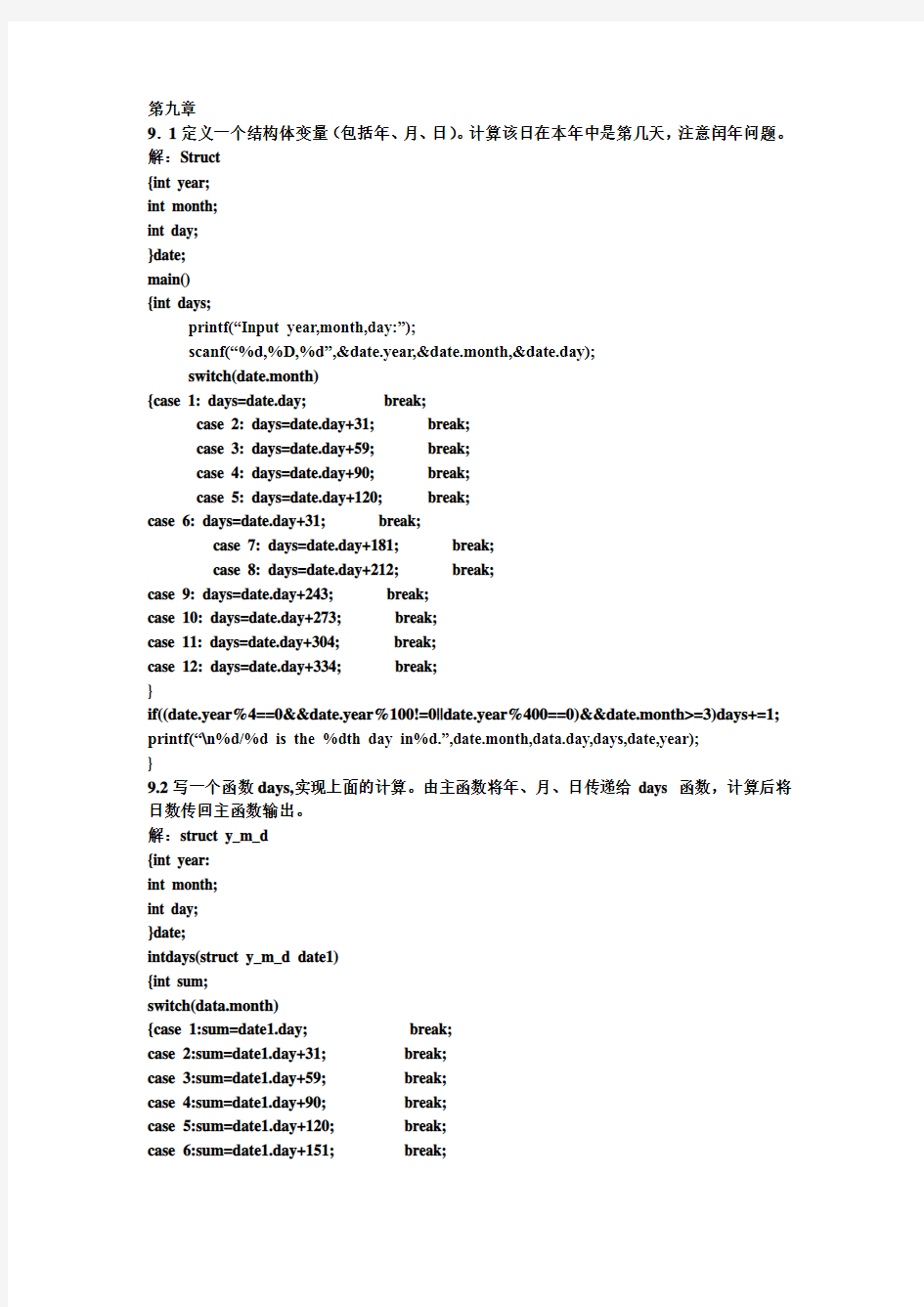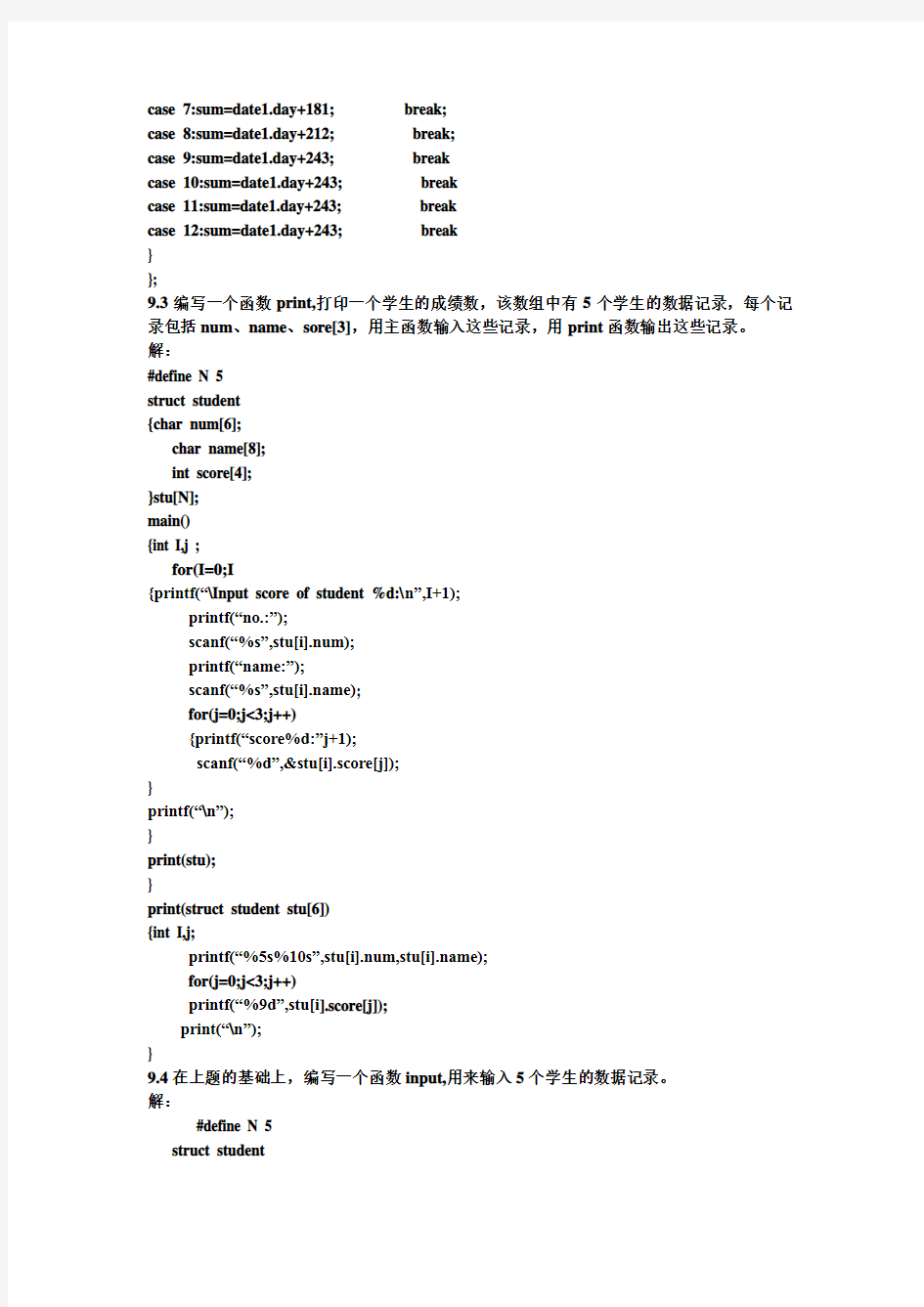(完整版)C语言程序设计第四版第九章答案谭浩强


第九章
9.1定义一个结构体变量(包括年、月、日)。计算该日在本年中是第几天,注意闰年问题。解:Struct
{int year;
int month;
int day;
}date;
main()
{int days;
printf(“Input year,month,day:”);
scanf(“%d,%D,%d”,&date.year,&date.month,&date.day);
switch(date.month)
{case 1: days=date.day; break;
case 2: days=date.day+31; break;
case 3: days=date.day+59; break;
case 4: days=date.day+90; break;
case 5: days=date.day+120; break;
case 6: days=date.day+31; break;
case 7: days=date.day+181; break;
case 8: days=date.day+212; break;
case 9: days=date.day+243; break;
case 10: days=date.day+273; break;
case 11: days=date.day+304; break;
case 12: days=date.day+334; break;
}
if((date.year%4==0&&date.year%100!=0||date.year%400==0)&&date.month>=3)days+=1; printf(“\n%d/%d is the %dth day in%d.”,date.month,data.day,days,date,year);
}
9.2写一个函数days,实现上面的计算。由主函数将年、月、日传递给days 函数,计算后将日数传回主函数输出。
解:struct y_m_d
{int year:
int month;
int day;
}date;
intdays(struct y_m_d date1)
{int sum;
switch(data.month)
{case 1:sum=date1.day; break;
case 2:sum=date1.day+31; break;
case 3:sum=date1.day+59; break;
case 4:sum=date1.day+90; break;
case 5:sum=date1.day+120; break;
case 6:sum=date1.day+151; break;
case 7:sum=date1.day+181; break;
case 8:sum=date1.day+212; break;
case 9:sum=date1.day+243; break
case 10:sum=date1.day+243; break
case 11:sum=date1.day+243; break
case 12:sum=date1.day+243; break
}
};
9.3编写一个函数print,打印一个学生的成绩数,该数组中有5个学生的数据记录,每个记录包括num、name、sore[3],用主函数输入这些记录,用print函数输出这些记录。
解:
#define N 5
struct student
{char num[6];
char name[8];
int score[4];
}stu[N];
main()
{int I,j ;
for(I=0;I {printf(“\Input score of student %d:\n”,I+1); printf(“no.:”); scanf(“%s”,stu[i].num); printf(“name:”); scanf(“%s”,stu[i].name); for(j=0;j<3;j++) {printf(“score%d:”j+1); scanf(“%d”,&stu[i].score[j]); } printf(“\n”); } print(stu); } print(struct student stu[6]) {int I,j; printf(“%5s%10s”,stu[i].num,stu[i].name); for(j=0;j<3;j++) printf(“%9d”,stu[i].score[j]); print(“\n”); } 9.4在上题的基础上,编写一个函数input,用来输入5个学生的数据记录。 解: #define N 5 struct student {char num[6]; char name[8]; int score[4] }stu[N]; input(struct student stu[]) {int I,j; for(I=0;I {printf(“input scores of student %d:\n”,I+1); printf(“NO.:”); scanf(“%s”,stu[i].num); printf(“name: ”); scanf(“%s”, stu[i].name); for(j=0;j<3;j++) {printf(“score%d:”,j++); scanf(“%d”, &stu[i].score[j]);} } printf(“\n”); } } 9.5 有10个学生,每个学生的数据包括学号、姓名、3门课的成绩,从键盘输入10个学生的数据,要求打印出3门课的总平均成绩,以及最高分的学生的数据(包括学号、姓名、3门课成绩) 解:#define N 10 struct student {char num[6] char name[8] int score[4] float avr; }stu[N]; main() {int I,j,max,maxi,sum; float average; for(I=0;I {printf(“\nInput scores of student %d:\n”,I+1); printf(“NO.:”); scanf(“%s”,stu[i].num); printf(“name”); scanf(“%s”,stu[i].name); for(j=0;j<3;j++) {printf(“score %d:”,j+1); scanf(“%d”, &stu[i].score[j]); } } average=0; max=0; maxi=0; for(i=0;i<3;i++) {sum=0; for(j=0;j<3;j++) sum+=stu[i].score[j]; stu[i].avr=sum/3.0; average+=stu[i].avr; if(sum>max) {max=sum; maxi=I; } } average/=N; printf(“NO. name score1 score2 score3 average\n”); for(I=0;I {printf(“%5s%10s”,stu[i].num, stu[i].name); for(j=0;j<3;j++) printf(“%9d”,stu[i].score[j]); printf(“%8.2f\n”,stu[i].avr); } printf(“average=%6.2f\n”,average); printf(“The highest score is:%s,score total:%d.”stu[maxi].name,max); } 9.6 编写一个函数new,对n个字符开辟连续的存储空间,此函数应返回一个指针,指向字符串开始的空间。New(n)表示分配n个字节的内存空间。 解:new函数如下: #define NULL 0 #define NEWSIZE 1000 char newbuf[NEWSIZE]; char *newp=newbuf; char *new(int n) {if (newp+n<=newbuf+ NEWSIZE) { newp= newp+n; return(newp-n); } else return(NULL); } 9.7写一函数free,将上题用new函数占用的空间释放。Free(p)表示将p指向的单元以后的内存段释放。 解: #define Null o #define NEWSIZE 1000 char newbuf[NEWSIZE]; char *newp=newbuf; free(char *p) {if((p>=newbuf)&&(p newp=p; } 9.8已有a、b亮光链表,每个链表中的结点包括学好、成绩。要求把两个链表合并,按学号升序排列。 解: #include #define NULL 0 #define LENsizeof(struct student) strut student {long num; int scor; struct student *next }; struct student listA,listB; int n,sum=0; main() {struct student *creat(void); struct student *insert(struct student *,struct student *); void print(struct student *); stuct student *ahead , *bhead,*abh; printf(“\ninput list a:\n”); ahead=creat(); sum=sum+|n; abh=insert(ahead,bhead); print(abh); } struct student *creat(void) {struct student *p1,*p2,*head; n=0; p1=p2=(struct student *)malloc(LEN); printf(“input number&scores of student:\n”); printf(“if number Is 0,stop inputing.\n”); scanf(“%ld,%d”,&p1->num,&p1->score); head=NULL; while(p1->num!=0) {n=n+1; if(n==1)head=p1; else p2->next =p1; p2=p1; p1=(struct student *)malloc(LEN); scanf(“%ld,,%d”,&p1->num,&p1->score); } p2->next=NULL; return(head); } struct student *insert(struct student *ah,struct student *bh) {struct student *pa1 , *pa2,*pb1,*pb2; pa2=pa1=ah; pb2=pb1=bh; do {while((pb1->num>pa1->num)&&(pa1->next!=NULL)) {pa2=pa1; pa1=pa1->next; } if(pb->num<=pa1->num) {if(ah=pa1) ah=pb1; else pa2->next=pb1; pb1=pb1->next; pb2->next=pa1; pa2=pb2; pb2=pb1; } } while((pa1->next!=NULL)||(pa1==NULL&&pb1!=NULL)); if((pb1->num>pa1->num)&&(pa1->next==NULl)) ap1->next=pb1; return(ah); } void print(struct student *head) {struct student *p; printf(“%ld%d\n”,p->num,p->score); p=p->next; while(p!=NULL); } 9.9 13个人围成一圈,从第1个人开始顺序报号1、2、3。凡报到“3”者退出圈子。找出最后留在圈子中的人原来的序号。 解: #define N 13 struct person {int number; int nextop; }link[N+1]; main() {int I,count,h; for(I=1;I<=N;I++) {if(I==N) link[i].nextp=1; else link[i].nextp=I+1; link[i].number=I; } printf(“\n”); count=0; h=N; printf(“sequence that person2 leave the circle:\n”); while(count {I=0; while(I!=3) {h=link[h].nextp; if(link[h].number) I++; } printf(“%4d”,link[h].number); link[h].number=0; count++; } printf(“\nThe last one is”); for(I=1;ii<=N;I++) if(link[i].number) printf(“%3d”,lin[i].number); } 9.10有两个链表a和b,设结点中包含学号、姓名。从1链表中删去与b链表中有相同学号的那些结点。 解: #define LA 4 #define LB 5 #define NULL 0 struct student {char nump[6]; char name[8]; struct student *next; }A[LA],b[LB]; main() {struct student a[LA]={{“101”,”Wang”},{“102”,”LI”},{“105”,”zhang”},{“106”,”Wei”}}; struct studentb[LB]={{“103”,”Zhang”},{“104”,”Ma”},{“105”,”Chen”},{“107”,”Guo”}, {“108”,”Lui”}}; int I,j; struct student *p, *p1,*p2,*pt,*head1,*head2; head1=a; head2=b; printf(“list a :\n”); for(p1=head1,i=1;p1 {p=p1; p1->next=a+I; printf(“%8s%8s\n”,p1->num,p1->name); p1=p1->next; } p->next=NULL; printf(“\n list b:\n”); for(p2=head2,I=1;p2 {p=p2; p2->next=b+I; printf(“%8s%8s\n”,p2->num,p2->name); p2=pa->next; } p->next=NULL; printf(“\n”); p1=head1; while(p1!=NULL) {p2=head2; while(p2!=NULL&&strcmp(p1->num,p2->num)!=0) p2=p2->next; if(strcmp(p1->num,p2->num==0)) if(p1==head1) head1=p1->next; else p->next=p1->next; p=p1; p1=p1->next; } p1=hedad1; printf{“\n result:\n”}; while(p1!=NULL) {printf(“%7s %7s\n”,p1->num,p1->name); p1=p1->next; } } 9.11建立一个链表,每个结点包括:学号、姓名、性别、年龄。输入一个年龄,如果链表中的结点所包含的年龄等于此年龄,则将此结点删去。 解:#define NULL 0 #define LEN sizeof(struct student) struct student {char num[6]; char name[8]; char sex[2]; int age; stuct student *next; }stu[10]; main() {struct student *p,*pt,*head; int I,length,iage,flag=1; int find=0; while(flag==1) {printf(“input length of list(<10):”); scanf(“%d”,&length); if(length<10) flag=0; } for(I=0;I {p=(struct student *)malloc(LEN); if(I==0) head=pt=p; else pt->next=p; pt=p; ptintf(“NO:”); scanf(“%s”,p->num); prntf(“name:”); scanf(“%s”,p->name); printf(“sex:”); scanf(“%s”,p->sex); printf(“age:”); scanf(“%s”,p->age); } p->next=NULL; p=head; printf(“\n NO. name sex age\n”); while(p!=NULL) {printf(“%4s%8s%6s%6d\n”,p->num, p->name, p->sex, p->age); p=p->next; } printf(“Input age:”); scanf(“%d”,&iage); pt=head; p=pt; if(pt->age==iage) {p=pt->next; head=pt=p; find=1; } else pt=pt->next; while(pt!=NULL) {if(pt->age==iage) {p->next=pt->next; find=1; } else p=pt; pt=pt->next; } if(!find) printf(“Not found%d.”,iage); p=head; printf(“\n https://www.360docs.net/doc/a42200752.html, sex age\n”); while(p!=NULL) { printf(“%4s%8s”,p->num,p->name); printf(“%6s%6d”,p->sex,p->age); p=p->next; } } 9.12将一个链表按逆序排列,即将链头当链尾,链尾当链头。解: # define NULL 0 struct stu {int num; struct stu *next; } main() {int len=1l struct stu *p1,*p2,*head,*new,*newhead; p1=p2=head=(struct stu * )malloc(sizeof(strct stu)); printf(“input number(0:list end):”); scanf(“%d”,&p1->num); while(p1->num!=o) {p1=(struct stu*)malloc(sizeof(struct stu)); printf(“input number(n:listend):”); scanf(“%d”,&p1->num); if(p1->num==0) p2->next=null; else {p2=>next=p1; p2=p1; len++; } } p1=head; pritnf(“\n the original list:\n”); do {printf(“%4d”,p1->num); if(p1->next!=NULL) p1=p1->next; } while(p1->next!=NULL) {p2=p1; p1=p1->next; } if(I==0) newhead=new=p1; else new=nes->next=p1; p2->next=NULL; } printf(\n\n The new listL\n); p1=newhead; for(I=0l;I {pritf(“4d,p1->num”); p1=p1->next, } printf(“\n”); }
